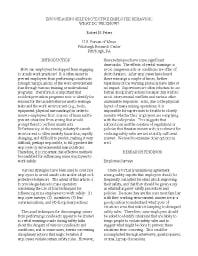Mining Publication: Encouraging Self-Protective Employee Behavior: What Do We Know?
Original creation date: January 1995
Authors: RH Peters
NIOSHTIC2 Number: 20023319
Proc 26th Annual Institute on Mining Health, Safety and Research, 1995, G.Tinney; A. Bacho; M. Karmis, eds. Blacksburg, Virginia: Virginia Polytechnic Institute and State University, 1995; :83-94
How can employees be stopped from engaging in unsafe work practices? It is often easier to prevent employees from performing unsafe acts through manipulations of the work environment than through various training or motivational programs. Therefore, it is important that accident prevention programs seek to identify the reasons for the unsafe behavior and to redesign tasks and the work environment (e.g., tools, equipment, physical surroundings) in order to remove employees from sources of harm and to prevent situations from arising that would prompt them to perform unsafe acts. Unfortunately, in the mining industry the work environment is often innately hazardous, rapidly changing, and difficult to predict, making it very difficult, perhaps impossible, to fully protect the employee by environmental manipulations. Therefore, it is important that effective methods be identified for influencing mine employees to work safely. Various strategies have been used to convince employees to avoid unsafe acts and/or adopt self-protective behaviors. The intent of this article is to provide guidance to mine operators concerning the use of four techniques for influencing mine employees to work safely: (1) employee surveys, (2) incentives, (3) fear communications, and (4) disciplinary actions. The usual techniques for discouraging miners from performing unsafe acts appear to be limited to verbal warnings made during safety talks about the dangers of various unsafe acts and conditions, and in some cases, threats concerning disciplinary actions that might be taken if employees violate certain safety rules. However, these techniques have some significant drawbacks. The effects of verbal warnings to avoid dangerous acts or conditions are often of short duration. After employees have heard these warnings a couple of times, further repetitions of the warning probably have little or no impact. Supervisors are often reluctant to use formal disciplinary actions because they wish to avoid interpersonal conflicts and various other undesirable responses. Also, due to the physical layout of many mining operations, it is impossible for supervisors to be able to closely monitor whether their employees are complying with the safety rules. This suggests that admonitions and the creation of regulations or policies that threaten miners with punishment for violating safety rules are not a totally sufficient answer. We need to examine other options as well.

NIOSHTIC2 Number: 20023319
Proc 26th Annual Institute on Mining Health, Safety and Research, 1995, G.Tinney; A. Bacho; M. Karmis, eds. Blacksburg, Virginia: Virginia Polytechnic Institute and State University, 1995; :83-94
- The Challenge of Enforcing Safety Rules in Remote Hazardous Work Areas
- Guidelines for Instructional Materials on Refuge Chamber Setup, Use, and Maintenance
- Knowledge Management and Transfer for Mine Emergency Response
- Make it Safer with Roof Screen
- Mine Rescue and Response
- Mine Rescue Training Facility Inventory - Compendium of Ideas to Improve US Coal Mine Rescue Training
- Mine Safety Education and Training Seminar: Proceedings: Bureau of Mines Technology Transfer Seminar
- Probability of Making a Successful Mine Escape While Wearing a Self-Contained Self-Rescuer
- Rock and Minerals Make up Your World: Rock and Mineral 10-Specimen Kit Companion Book
- Technology News 535 - NIOSH Releases New Educational Video: Escape from Farmington No. 9: An Oral History